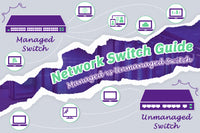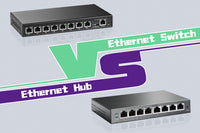Contents
Network switches allow network devices to communicate with each other in Local Area Networks (LANs). Modern network systems are largely reliant on these network switches. Switches can be divided into different types, including layer 2 and layer 3 switches, managed or unmanaged switches, as well as PoE or non-PoE switches. Each type of network switch offers different functions and features, catering to specific network requirements.
Should you use a Layer 2 or Layer 3 switch for your network? Let’s find the answers in the following post.
Network Switch Explained
Data packets play an essential role in the interaction of different network devices and the network switch is an indispensable hardware to facilitate this communication efficiently. There are different types of network switches, such as layer 2 and layer 3 switches, managed or unmanaged switches, and PoE switches. Also known as a switching hub or Ethernet switch, the network switch is used with different data cables for connectivity between multiple computers and other IoT devices. It ensures smooth data flow across the network by transferring and receiving data from the targeted devices using data packets.
OSI Model Layers Explained
To know better about layer 2 and layer 3 switches, it’s essential to grasp the layered architecture of network switches. The Open Systems Interconnection (OSI) model was created by the International Organization for Standardization (ISO) in 1980. The OSI model defines the necessary hardware and software for the network, making technicians know how the network functions and troubleshoots network issues. The model divides network communication into seven different abstraction layers: physical, data link, network, transport, session, presentation, and application layers.
The physical layer is responsible for data transfer between physical equipment and physical transmission medium. This physical equipment involves cables, connectors, switches, and routers. This layer manages the conversion of unstructured raw bit stream data in the form of 0s and 1s.
The data link layer enables data transmission directly between two connected nodes on the same network. It is also responsible for error diagnosis and correction over the physical layer. It receives the data packets from the network layer, breaks them into frames, and finally forwards them to the destination. The data link layer can be classified into Medium access control (MAC) and Logical link control (LLC) layers.
The network layer transmits data between different networks. It gets segments from the fourth layer (transport layer) and splits them into data packets. These small packets are assembled at the endpoint device. This layer also handles routing to ensure the optimal transmission path.
The transport layer handles terminal communication between devices. It is responsible for receiving data from the session layer and breaking them into network segments on the network layer. Then the transport layer rearranges and converts these segments into data that can be used in the session layer. The fourth layer deals with the network traffic and ensures the correct data transmission.
The session layer creates the session between two or more devices. It is responsible for the creation, maintenance, and termination of the session between computers. This ensures that the time is sufficient for data transmission. This layer also sets checkpoints to ensure smooth data transmission.
The presentation layer, also called the translation layer, is responsible for data translation, encryption, decryption, and compression. This layer takes data from the application layer and translates the data into the syntax that is usable for the application layer.
At the top layer of the OSI model, the application layer interacts with the user-side data. It enables the communication between software applications and end users. It allows the software to produce the data and present meaningful results to the users by using protocols like Hypertext Transfer Protocol (HTTP) and Simple Mail Transfer Protocol (SMTP).
According to the OSI model, Layer 2 and Layer 3 switches work at the data link and network layer respectively.
What is Layer 2 Switch?
At the second layer of the OSI model, a layer 2 switch handles the data link. The layer 2 switch usually has an address table to keep track of the media access control (MAC) address from one port to the destination port. It switches data packets based on the physical address to ensure that data traffic is directed to the correct receiver.
The emergence of the Layer 2 switch has replaced the traditional networking bridge and forwards data very quickly. Each port on the switch breaks the large collision domain so each of it facilitates fast data transmission with low latency.
The Layer 2 switch is cost-effective and can be easily deployed, making it ideal for data transmission within segments on a LAN or adjacent segments in a WAN.
Key Features / Functions:
- Supports Spanning Tree Protocol (STP) to avoid network loops by prohibiting redundant links;
- Forwards data frame quickly with the learned MAC address;
- Allows for link aggregation, merging physical ports into a single logical connection to increase the bandwidth;
- Features independent collision domain to avoid collision and enhance network performance;
- Support VLAN and can divide a LAN into small VLANs, allowing users to manage different logical networks.
What is Layer 3 Switch?
The Layer 3 switch is located at the third layer of the OSI model. While maintaining the functions of Layer 2 switches, Layer 3 switches incorporate the routing function in the network layer, meaning that they can use both MAC and IP addresses for data transmission. It functions fast dynamic routing and share routing tables between multiple networks but it does less than a Router.
The switch can handle traffic across a LAN or VLAN, providing an efficient solution for more complex network environments. Layer 3 switches can be seen as the integration of traditional switches and routers.
Key Features / Functions:
- Routing capabilities allow for the best path for traffic;
- Supports different routing protocols, such as RIP, BGP, and OSPF;
- Isolates each independent broadcast domain to enhance network security;
- Offers easy VLAN management.
Note: What is Layer 4 Switch?
A Layer 4 switch is an enhanced version of a Layer 3 switch, which is also known as the transport layer or content switch. This type of switch forwards data packets based on MAC address, IP address, and the application.
A Layer 4 switch functions like a firewall by monitoring the state of the entire session. It offers many advanced features such as traffic filtering, load balancing, and security shielding.

Layer 2 vs. Layer 3 Switch: What Are the Differences?
Understanding the differences between Layer 2 and Layer 3 switches is essential for deploying an efficient and scalable network infrastructure. As previously mentioned, Layer 3 switches offer additional routing functions compared to Layer 2 switches. However, their differences extend beyond routing capacities. To learn more about this, read on for more information.
- Routing Function
One of the main differences between Layer 2 and Layer 3 switches is their routing capabilities. Layer 2 switches forward packets based on MAC address and it has no routing capabilities between different network segments. In contrast, Layer 3 switches support routing functions based on IP addresses between multiple VLANs. They support both dynamic and static routing.
- Cost
A Layer 2 switch is more affordable than a Layer 3 switch but features fewer functions. The Layer 3 switch is generally more expensive but provides advanced features. If you have a limited budget, your option for Layer 3 switches may be more restricted. In addition, Layer 3 switches usually come with complex configurations.
- Broadcast Domain
A Layer 2 switch only has a single broadcast domain, which covers all devices connected to the switch within the same VLAN. A Layer 2 switch may cause a potential domain storm in large networks. In contrast, a Layer 3 switch has multiple VLANs. Each VLAN can be seen as a separate broadcast domain, which reduces unnecessary broadcast traffic.
- Speed
Typically, Layer 2 switches enable a fast data transmission than Layer 3 switches as they require fewer network hops for in-network communication. Layer 3 switches can be fast but they usually require more processing power to examine the data packets across different networks.
- Security
Network security is of paramount importance for a network system. Layer 2 switches lack advanced security capabilities, while. Layer 3 switches are built with many security features, such as loopback detection, access control lists (ACLs), DHCP snooping, Dynamic ARP inspection (DAI), and so on. Compared to Layer 2 switches, Layer 3 switches offer enhanced security features and they are less susceptible to cyber threats.
|
Comparison |
Layer 2 Switch |
Layer 3 Switch |
|
Cost |
More cheaper |
More expensive |
|
Routing Function |
Limited or no routing functions |
Routing functions between different network segments |
|
Broadcast Domain |
Single |
Multiple |
|
Speed |
Faster |
Slower |
|
Communication Scope |
Within a network |
Intra-VLAN and extra-VLAN communication |
|
Security |
Less built-in security features |
More built-in security features |
|
Address |
MAC address |
IP address |
Layer 2 vs. Layer 3 Switch: Which to Choose?
There are various factors you need to consider when choosing between Layer 2 switches and Layer 3 switches. But it all depends on your particular network needs.
When to Use Layer 2 Switches?
For small and medium-sized offices, Layer 2 switches can meet your basic networking needs. They don’t require complex configurations so they are easy to set up for your local segments. They are not very expensive and also provide sufficient switching capacity with multi-port options, allowing you to communicate within the same local network in small offices. They are also equipped with basic security features and support high-speed connectivity, making them ideal for a network segment or a VLAN.
When to Use Layer 3 Switches?
For large-scale LANs, Layer 3 switches are suitable and can meet the requirements for advanced functions and enhanced security features. They offer higher throughput and SPF+ ports, which are ideal for minimizing network congestion in complex traffic patterns with thousands of users. With routing functions, they provide a robust solution for sharing loads and selecting optimal routes within multiple networks. Layer 3 switches are well-suited for security management as they offer advanced security features like IP Source Guard and ARP inspection. Layer 3 switches also support Quality of Service (QoS) to ensure traffic prioritization. If you consider all of these factors, layer 3 switches are surely needed for your future networks.
Conclusion
Both layer 2 and layer 3 switches play a crucial role in modern network systems. The key difference between them is the routing capability. A Layer 2 switch works at the data link layer, which is a straightforward solution to networks. A Layer 3 switch works at the network layer and offers great security features and great scalability for complex networks in modern business environments. But in some cases, layer 2 and layer 3 switches can be combined to create the optimal networking efficiency. Choosing between these two types of switches still relies on your specific needs. We’ve learned the definitions of both switches and compared their features and functions. Hopefully, you will find the ideal choice based on your actual needs.
FAQs
1. Can a Layer 3 switch operate at Layer 2?
Yes, it maintains the features of a Layer 2 switch but offers additional routing capabilities.
2. Can a Layer 3 switch replace a router?
In theory, a Layer 3 switch can replace a router. But in real life, a Layer 3 switch can’t support more advanced features like larger packet buffers and BGP support. So, a Layer 3 switch cannot totally replace the router.
3. What layer is the unmanaged switch?
The unmanaged switch operates in the second layer (data link layer).
For more information on this topic, you can keep up on our blogs. While VCELINK offers general and basic information for our customers and other visitors to the website, it’s not professional advice.



Be the first one to comment.
Leave a comment